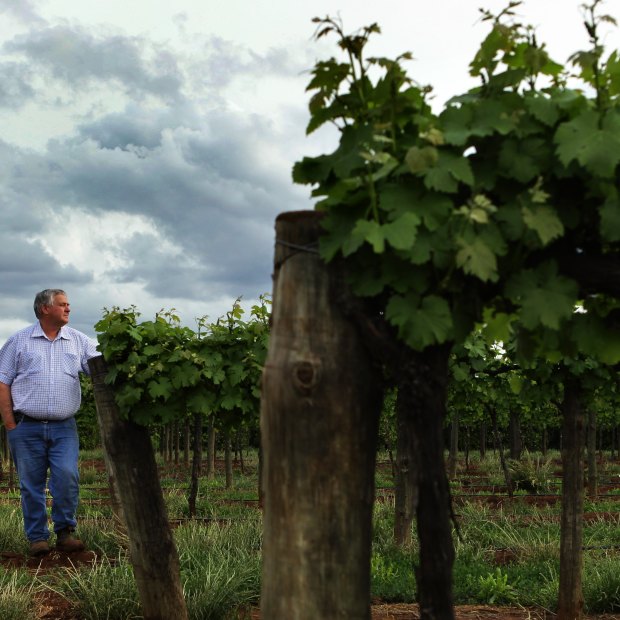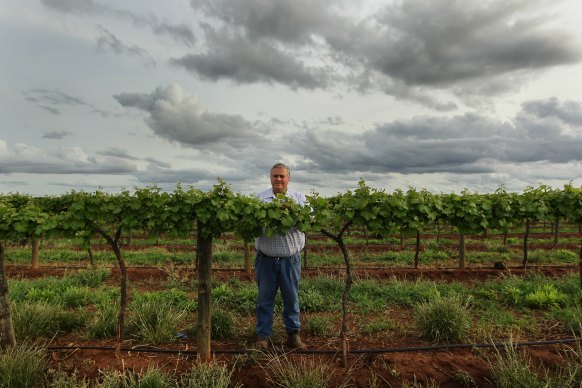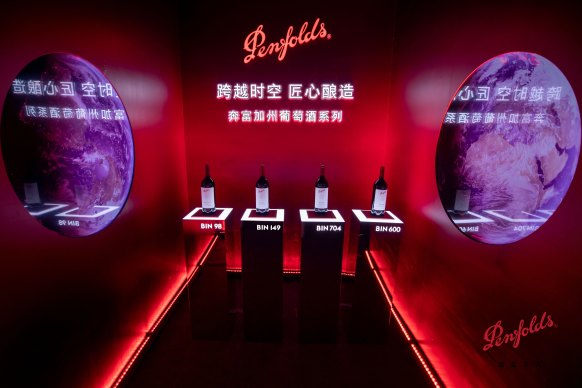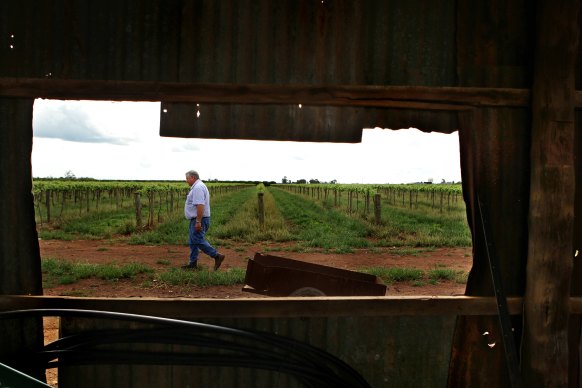By Jessica Yun
Winegrape grower and Riverina Winegrape chairman Bruno Brombal on his property in Hanwood, NSW.Credit: Kate Geraghty
Save articles for later
Add articles to your saved list and come back to them any time.
Bruno Brombal has been growing and selling wine grapes from his 150 hectare family farm in Griffith, NSW, for about half a century. He recalls the golden years of 2019 and 2020, when red grapes would command a price of up to $600 per tonne.
Nowadays, he’s looking at a fraction of that.
“This year, they’re talking $150 [per tonne]. It’s all got to do with the China market,” Brombal said. “We’re way below cost of production.”
Winegrape grower and Riverina Winegrape chairman Bruno Brombal on his property in Hanwood, NSW.Credit: Kate Geraghty
In an attempt to get around the rock-bottom wine grape prices, Brombal been busy ripping up 10 hectares worth of red grape vines to plant citrus instead. Next year could mean another 10 hectares replaced by pomegranates.
The 71-year-old considers himself as one of the luckier ones as he observes some of his peers, who only grow wine grapes, struggling to survive. Supply chain knots from the global pandemic and Russia’s war on Ukraine pushed up the price of crucial input costs such as fertiliser, fuel, and chemicals. Interest rates are also biting.
“We just can’t keep working for nothing. Our expenses are too high,” said Brombal, who is also the chairman of Riverina Winegrape Growers.
“Some growers have stated this will be their last year. If things don’t change, they’re gone.”
Brombal is one of thousands of grape growers and winemakers who are still dealing with the aftermath of Beijing’s five-year tariffs of more than 200 per cent, imposed in 2021 when Australia-China relations hit at an all-time low under then prime minister Scott Morrison, crippling a billion-dollar industry.
While the wine industry is keenly watching for signs that Beijing might lift its hefty tariffs, as it did with barley and coal earlier this year, few are banking on the return of the Chinese market as a silver bullet.
Industry insiders fear the damage has been too deep. Since the tariffs, the wine sector has been grappling with an oversupply of red wine, particularly in commercial wine and in ‘heavy red’ varieties like shiraz, cabernet sauvignon and merlot. In June 2022, national wine inventory levels came at nearly 2.3 billion litres, a 15-year record high, according to KPMG’s latest wine industry report.
“Should, or when, China opens up again, whenever that may be, there’s no doubt it’ll still provide significant opportunity for Australian producers,” said Wine Australia marketing general manager Paul Turale.
“But it would be naive for us to think it’s going to go back to what it was back in 2019.”
The lucrative export market – once worth $1.3 billion at its 2019 peak – has plunged to $8.1 million in the 12 months to June this year, representing a 99.4 per cent fall. By volume, the 140 million litres of wine we used to sell to China, comprised almost entirely of red wine, has slowed to a 1 million trickle.
The issue of millions of litres of red wine with nowhere to go was exacerbated by a bumper harvest in 2021. Against this backdrop, wine has continued to decline in popularity, a global trend that has been going on for a decade as younger drinkers display a preference for lighter, low-calorie, and conveniently packaged premixed beverages like seltzers.
Even by optimistic standards, it will take two years to clear the current oversupply, equivalent to 2.8 billion bottles or 859 Olympic swimming pools, according to Rabobank analysis.
“The two years rests on the assumption the China market will recover quickly,” said Rabobank associate analyst Pia Piggott. “The next few years will be quite difficult, no matter what happens.”
The red wine glut isn’t just affecting small-time players: those at the top end of town are watching these trends closely and adjusting their business model accordingly. Luxury and premium winemakers are still seeing customers happy to pay for a top drop; for instance, Treasury Wine Estates was able to successfully pass on price increases to its flagship Penfolds brand, but will close one of its wineries used to make budget brands as customers snub plonk in favour of higher-quality wine.
Treasury Wine Estates began making its own China-made version of Penfolds as part of a new strategy when China imposed harsh tariffs on Australian exports.
“People are drinking less but drinking better,” Turale said.
The warm inland regions – the Riverland, Murray Darling and Riverina, which collectively produce about 70 per cent of the country’s annual grape crush – have been hit hardest. Meanwhile, cooler regions such as Tasmania, the Barossa Valley, the Yarra Valley, the Hunter Valley and Margaret River make up the premium sector and are seeing their average value per tonne steadily increase.
“There are certain regions within the country that can’t produce enough wine at the moment,” Turale said. “Most of that oversupply tends to be concentrated in the bigger, warmer inland regions that supply more commercially priced wines.”
Winemakers have also sought to fill the gaping China-sized hole by drumming up demand in other Asian markets like Hong Kong and Thailand. The UK and the US are Australia’s top two export markets, representing about 39 per cent of total wine exports in value and 57 per cent in volume, but demand from both went backwards in the 2023 financial year. At its peak, the Chinese market was worth more than the US and UK market combined.
China has moved on
Some grape growers and winemakers, such as Riverina farmer Robert Bellato, have read the cards and decided the time is ripe to exit.
While the removal of the hefty import duties would be welcome news, those who remain in the industry are mulling their options.
Some, like Brombal, are ripping up vines to plant other types of produce. Others are grafting white wine grapes instead of red, while others yet are ‘mothballing’ their vineyard, a practice to maintain a non-producing grape vine with minimal but critical inputs like water or sprays.
KPMG turnaround and restructuring lead Tim Mableson is seeing more advertisements of vineyards being put up for sale in the warm inland regions. “However, these markets are under pressure with a diminishing buyer pool and fall in valuations,” he said. If the China doesn’t return, the value of these vineyards will keep falling further.
Those still in the game but struggling to make ends meet are being urged to consider their options, though Mableson acknowledged that uncertainty often creates inactivity or indecisiveness.
“It is critical grape growers start engaging with their winery contacts now and seeking advice as early as possible.”
If or when China opens back up, the demand for wine won’t be the same: wine consumption in China has been declining for the past decade. “Anecdotally, we are hearing consumers in China are moving away from wine towards spirits, especially whiskey,” Mableson said.
It will take some time for Australian winemakers to rekindle business relationships and re-establish their foothold in the Chinese market. Even then, they will be competing with producers from France and Chile, which have established a strong market share in Australia’s absence. They are the top two exporters of wine to China, representing a combined value of $1 billion.
With no immediate relief in sight, Brombal will cut back on fertiliser, sprays, chemicals and maintenance to cut costs over the next six to 12 months.
In Griffith, the harvest period will begin in late January or February and finish up by the end of April. The oversupply will mean some fruit likely won’t get picked. “We could have red grapes sitting on the vine,” he said.
Grape grower Bruno Brombal is worried about the mental health of farmers and the future of the winegrape growing industry.Credit: Kate Geraghty
The tariffs’ damage has been more than just financial. “The worst thing around this region is mental health,” Brombal said.
With so many tough years back to back, it’s a difficult sell to keep young ones on the farm, stirring concerns about the industry’s future.
“I’m very concerned about them, what the future’s going to hold,” he said.
“These people are the next generation.”
The Business Briefing newsletter delivers major stories, exclusive coverage and expert opinion. Sign up to get it every weekday morning.
Most Viewed in Business
Source: Read Full Article



